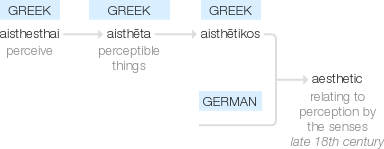Aesthetic
late 18th century (in the sense ‘relating to perception by the senses’): from Greek aisthētikos, from aisthēta ‘perceptible things’, from aisthesthai ‘perceive’. The sense ‘concerned with beauty’ was coined in German in the mid 18th century and adopted into English in the early 19th century, but its use was controversial until much later in the century.
wiktionary
From German Ästhetik or French esthétique, both from Ancient Greek αἰσθητικός(aisthētikós, “of sense perception”), from αἰσθάνομαι(aisthánomai, “I feel”).
etymonline
aesthetic (n.)
1798, from German Ästhetisch (mid-18c.) or French esthétique (which is from German), ultimately from Greek aisthetikos "of or for perception by the senses, perceptive," of things, "perceptible," from aisthanesthai "to perceive (by the senses or by the mind), to feel," from PIE *awis-dh-yo-, from root *au- "to perceive."
Popularized in English by translations of Kant and used originally in the classically correct sense "science which treats of the conditions of sensuous perception" [OED]. Kant had tried to reclaim the word after Alexander Baumgarten had taken it in German to mean "criticism of taste" (1750s), but Baumgarten's sense attained popularity in English c. 1830s (despite scholarly resistance) and freed the word from philosophy. Walter Pater used it (1868) to describe the late 19c. movement that advocated "art for art's sake," which further blurred the sense. [Whewell had proposed callesthetics for "the science of the perception of the beautiful."]
As an adjective by 1798 "of or pertaining to sensual perception;" 1821 as "of or pertaining to appreciation of the beautiful." Related: Aesthetically.
